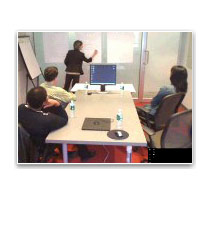Services
-
Services
Our Suite.
Catalyst offers much more than "typical" Interactive Agencies. Although we provide the same design, research, and strategy services, our methods are grounded in a long tradition of usability and human factors disciplines and our fact-based discovery and testing services are woven deeply into every project. At Catalyst, our whole approach to design is built on our fundamental philosophy that effective interactive experiences require keen insights and observations about likely user behavior and time-tested design approaches that have been proven to help users accomplish their goals.
-
User Interface Design
User Interface Design
We demand a lot from our "user interfaces" these days. They must be powerful and visually appealing while also being fast and easy to use. We expect them to anticipate our needs but not force us into a particular path. Effective User Interface Design is about helping people to accomplish desired tasks in a way that makes sense to them. Specific design solutions may vary across different platforms (such as websites, applications, kiosks, and handhelds) and different industries, but the ultimate goal is always the same: to provide an experience that is efficient and satisfying. Our design process insures that our clients' products and services achieve the delicate balance of innovation and familiarity that is required for a successful interaction.
Application Design
In addition to a keen understanding of application architecture and data presentation and manipulation, successful application design consulting requires a unique ability to rapidly absorb the details and nuances of a client's business. In fact, many clients have told us that, at the completion our work together, they believed that we understood their application better than most of their own employees! We have delivered world-class application user interface design solutions in a wide variety of industry verticals. Contact us to learn more about specific Catalyst projects and to discuss your needs.
Representative Clients
- DoubleClick
- John Wiley & Sons
- Hearst Magazines
- Thomson Healthcare
- Conductor
- Galileo International
- Epiq Systems
Content & Media Sites
Catalyst has extensive experience providing major content portals with Design and Usability Services specifically tailored to address their unique business objectives. Few firms can match Catalyst's experience with the design of online consumer-facing interfaces, particularly ad supported, content-based sites for which best-of-breed site organization and navigation are mission-critical objectives. We have a particular expertise in the integration of IAB ad formats into templates; striking the delicate balance between the economic realities of ad-supported businesses and the site visitor's need for a usable and engaging experience.
Representative Clients
- About.com
- iVillage
- Time.com
- CNNMoney
- The New York Post
- Comedy Central
- Latina.com
Mobile Web and Applications
Mobile applications and websites are a tremendous opportunity for companies to establish more intimate and long-lasting customer relationships. But the opportunity comes with challenging constraints and complexities. Successfully navigating this opportunity / constraint landscape requires more than an up-to-date understanding of the latest mobile fads; it requires a measured, fact-based mobile user experience design process. Contact us to learn more about our Mobile User Interface Design services.
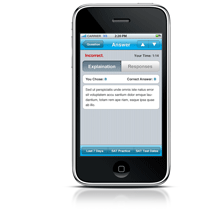
-
Experience Strategy
Experience Strategy
Many projects begin with a "blue sky" exploration of how a site or application should look, feel, and function in order to deliver the best experience to the users. Catalyst's long experience working closely with end users to understand their preferences and behaviors have taught us a lot about what works and what typically doesn't. Plus our designers are experts at thinking outside the box – often by importing UI constructs and techniques from other contexts and using them in a novel fashion. The result is an Experience Strategy that provides a set of clear guidelines to inform the design process and insure success.
Brainstorming
Effective brainstorming is more than just a crowd of people in a room hashing out ideas. When we facilitate brainstorms with clients, we run a tight ship. The key is to have clear objectives for the sessions and to focus on idea generation as opposed to idea evaluation. This is harder than it sounds but the results can be extremely fruitful, especially when combined with insights gleaned from members of a site's target audience.
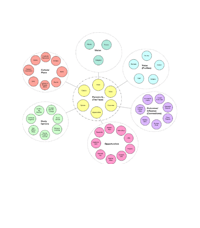
Prototyping
When a great idea emerges out of brainstorming or other strategy activities, it is crucial to be able to express this idea in an efficient and effective fashion; to prototype not just the design but also the overall experience that is intended. Sometimes this just means clear wireframes, sometimes visual design and even interaction prototyping are required to get the point across. Whatever is necessary, we rapidly generate a facsimile of the target experience so that clients and customers can provide meaningful feedback.
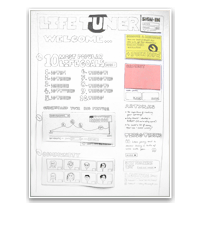
-
Visual Design
Visual Design
Visual Design, or the application of a graphic identity to an underlying user interface, is obviously a vital aspect of a successful design. Many usability specialists discount the role of visual design, but we disagree. That's why our Visual Design team works closely with the user interface designers to determine exactly the role that visual elements should play. Sometimes this role is a supporting one, as in the case of complex application designs. Just as often, our visual designers enhance the overall usability and appeal of the interaction by making it more interesting and engaging. Whatever the requirements, our design teams work hand-in-hand to deliver a design that balances the needs of visual appeal and usability appropriately.
Concept Development
During Concept Development, we explore a wide range of design alternatives based on the branding and design guidelines that we have established in a Design Brief, Moodboards, or other techniques. More than just color choices, alternative concepts can vary the style, sensibility, and presence of a design, as well as the use of images or illustrations and different font treatments. The goal is to narrow the field to a small selection of options and then refine the design elements – sometimes making several rounds of adjustments until everything is in balance. The final design is then applied to all the pages required for the site or application.
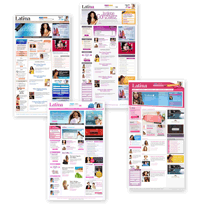
Template Design
There is a particular art to Template Design that is often underestimated. Applying a consistent visual treatment to a set of diverse wireframes that often have unique user interface elements is a challenging process. Our designers are particularly experienced at the iterative, evolutionary design process that this activity requires – insuring that the first template still resembles the last by the time that the last is delivered. We rarely produce all the pages necessary for implementation – instead we provide clients with a set of Template “tools” that they can use to build the site and expand it over time.
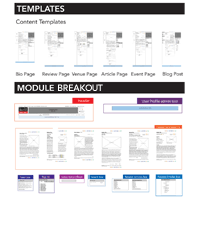
-
Expert Evaluations
Expert Evaluation
There are many situations in which an expert opinion is the best solution. Our clients often ask us to analyze their products (both pre- and post-launch), sometimes in comparison with competitors or "comparators" in order to learn from what others are doing well. It's a quick and cost-effective way to address many design and usability issues that could be interfering with business success.
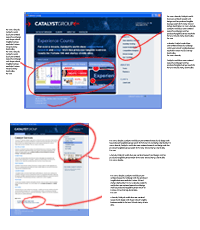
Heuristic Evaluations
Heuristic Evaluation is a structured methodology for evaluating a site or application based on a pre-established set of principles or "heuristics" that guide the assessment. At Catalyst we assign at least two experienced usability analysts for each evaluation project to maximize the value of our observations and recommendations. At the end, we deliver a concise and actionable Heuristic Evaluation Report that describes the problems we’ve found and suggests real solutions for improvement.
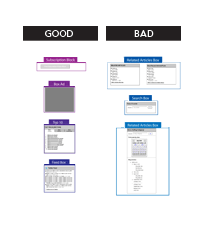
Competitive Analysis
Competitive Analysis involves a process that is similar to Heuristic Evaluation of a single product – except that we include multiple sites or applications in our review. Clearly, we are most interested in what competitors are doing right and in assisting our clients with learning from these choices. Competitive Analysis is an excellent way to benchmark a current design prior to redesign and to begin to explore new features and functions for consideration.
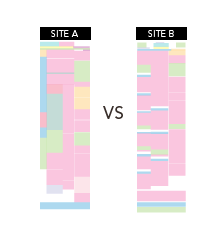
-
Eye Tracking
Eye Tracking
Effective deployment of Eye Tracking technology requires an exceptionally deep understanding of design and user behavior. Catalyst's many years of experience with Usability Testing have positioned us well to help our clients take advantage of this exciting new technology. Eye Tracking literally tells you where website users are looking on a screen as they attempt to complete a specific task or simply explore freely. This information can help inform decisions about a variety of key design elements, such as task workflow, site navigation, and advertising placement and formats. Combined with "talk-aloud" Usability Testing, Eye Tracking can help complete the research picture by supplementing what users "say" with what their eyes "see."
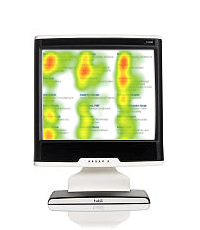
Heat Maps
Heat Maps graphically illustrate the intensity of attention that certain areas of a page received from a group of participants. This graphical representation of the eye tracking data is invaluable for understanding how users explore a page and how much of it they actually see – including whether or not they scroll to the bottom. Heat Maps generated from the first few seconds of viewing a page provide insight into what immediately catches users' eyes as they explore. Heat Maps of task-attempts indicate where on a page users expect certain content or functions to be.
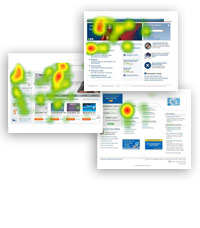
Gaze Plots
Gaze plots indicate the progression of an individual user's visual exploration of a page; what they see first, where they pause (and for how long), where they look next, and so on. Gaze plots sketch a path of attention around a page and can tell you whether users find the page orderly and structured or confusing and fragmented. Using a technique called Retrospective Think Aloud, we can also replay the video of a test participant's gaze plot to them in order to aid in recollection of what they were thinking and noticing as they explored.
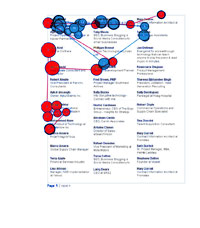
Zone Analysis
Zone Analysis breaks a page design into modules or zones and provides data regarding how these zones were seen (or not) by participants; how often they returned to a certain zone, and how long they fixated on it. In conjunction with Heat Maps and gaze plots, Zone Analysis provides assessment of how a design is performing "in a user’s eyes."
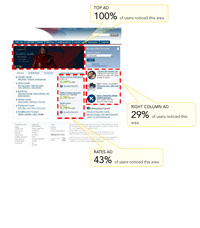
-
Usability Testing
Usability Testing
Catalyst is a leading provider of lab-based testing, eye tracking, and other usability research services. We have conducted thousands of usability test sessions on a wide variety of website, software, and handheld interfaces. Our methods can unearth crucial insights into overall usability, navigability, as well as questions of product comprehension and general appeal. Deployed early in the product development process, usability research can help focus the experience design on aspects that will most engage and satisfy end users.
Lab-Based Testing
Usability Testing in a lab environment is an ideal method for a variety of mission-critical research objectives, including determining whether users can complete key tasks, whether they "get" an interface, to assess the effectiveness of a new design direction, or compare similar experiences on competitor websites. Lab-Based Testing provides detailed, in-depth, actionable feedback about the tested user experience, including, in many cases, immediate reactions to design changes made in real time during testing.
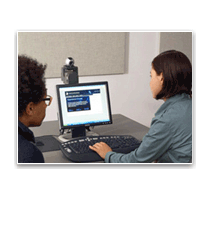
Café Testing
Catalyst is pioneering a new form of informal usability testing – which we call Café Testing – in which we locate our mobile testing lab in a public setting (such as a Café or professional conference) and hand-recruit customers or attendees to participate in testing. Interviews are shorter than lab tests and typically more general in nature; less focused on task completion. Café Testing is great for acquiring more general feedback about user ideas and opinions, testing or concept evaluation in more realistic environments, and pre-design research where the results are used to shape the beginning of a new design.
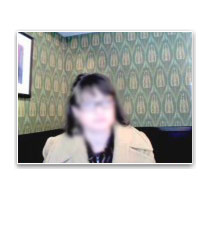
Mobile Devices / iPads
Catalyst's research team has developed an array of highly customized lab setups, moderation techniques, and formats for results analysis and reporting that are specific to the unique and variable needs of mobile / tablet usability testing. As a result, we have successfully delivered highly relevant insights for clients across a broad spectrum of customer and product types, including work with major Media clients to refine cutting-edge mobile content presentation experiences. Please contact us to learn more.
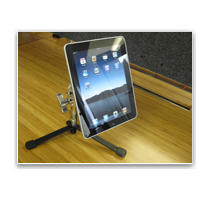
Mini Groups
Similar to focus groups, but with fewer participants per group, Mini-Groups are a great technique for understanding what people expect from a web site or application before you've even begun the design process. Mini-Groups can be used to quickly collect a diverse set of reactions to concepts and assess likelihood of appeal / acceptance by the target audience. Small groups of people (5 or fewer) discuss topics or to review ideas related to a concept. A moderator runs the sessions to keep participants on point and to ensure everyone has an opportunity to express their opinions. Participants may report on tasks or activities they have conducted prior to the meeting such as journals, collages, or participation in an online forum prior to the discussion.
